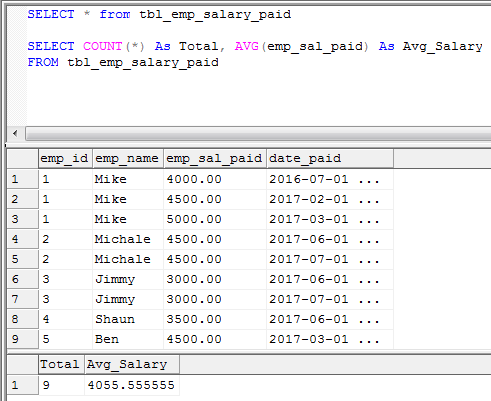
The GROUP BY with HAVING clause retrieves the result for a specific group of a column, which matches the condition specified in the HAVING clause. Der SQL Befehl HAVING kann man als WHERE des GROUP BY bezeichnen. HAVING folgt immer dem GROUP BY, kann also nicht davor stehen. Mit HAVING kann man die Ausgabe auf. SQL GROUP BY Examples ProbleList the number of customers in each country.
Only include countries with more than customers. SELECT COUNT (Id), Country FROM. Browse other questions tagged sql count group-by having or ask your own question.
If the HAVING clause contains a subquery, the subquery can refer to the outer query block if and only if it refers to a grouping column. Specifies a search condition for a group or an aggregate. HAVING is typically used with a GROUP BY clause. When GROUP BY is not use there is an implicit single, aggregated group. This function returns the number of items found in a group.

COUNT operates like the COUNT_BIG function. These functions differ only in the data types of their return values. The Oracle HAVING clause will filter the so that only departments with more than employees will be returned.
La condition HAVING en SQL est presque similaire à WHERE à la seule différence que HAVING permet de filtrer en utilisant des fonctions telles que SUM(), COUNT (), AVG(), MIN() ou MAX(). The COUNT () function returns the number of orders each customer placed in each year. Secon the HAVING clause filtered out all the customers whose number of orders is less than two. SQL Server HAVING clause with the SUM() function example.
The sql having also be used with sql max function. The following statement returns the brand and the number of products for each. Mit WHERE kann man nur einen bestimmten Bereich einschränken, sobald man Werte gruppiert und Einschränkungen anhand der Gruppierung machen möchte, benötigt man HAVING. Gerade für die weiteren SQL Funktionen, auf die wir im nächsten Teil eingehen werden, wird HAVING häufig benötigt.
So könnten wir zum Beispiel nur diejenigen Warenhäuser anzeigen lassen, die einen Umsatz von mehr als 1. For example, you can use the HAVING clause to answer questions like finding the number orders this month, this quarter, or this year that have total sales greater than 10K. We often use the HAVINGclause in conjunction with the GROUP BY clause to filter group rows that do not satisfy a specified condition. We use the COUNT function with the HAVING and GROUP BY clauses. It was added to the SQL language because the WHERE keyword could not be used with aggregate functions. Für diese Aggregatfunktion gibt man einfach das Schlüsselwort COUNT , samt der Name der zu zählenden Datensätzen in den Klammern an: COUNT (name) Zu beachten ist, dass dabei alle Datensätze gezählt werden, bei denen die entsprechende Spalte nicht NULL ist!
Anbei ein einfaches Beispiel für die Demonstation der COUNT ()-Syntax in SQL. SQL HAVING with COUNT function example. Let’s take some examples to see how the COUNT function works.
We will use the employees table in the sample database for the demonstration purposes. SQL COUNT function examples. Combining the two: WHERE and HAVING. The HAVING clause is evaluated after the grouping is created. When SQL statements have both a WHERE clause and HAVING clause, keep in mind the WHERE clause is applied first, then the groupe and finally the groups filtered according to the HAVING clause.

Dieser SQL -Befehl wird häufig in Kombination mit den Aggregatfunktionen verwendet. The SQL Having clause is used to filter summary from a GROUP BY. It specifies the search condition for the group or aggregate.
Navicat中可以看到表中所有数据,如图所示,可见表中有297条数据. Similarly, if you want to count how many employees in each department of the company. It groups the databases on the basis of one or more column and aggregates the.
Today we'll learn how to write slightly more complex queries that let us ask questions about groups of records. HAVING Clause returns the grouped records which match the given condition. The first minutes will be lecture and. Meseleyi daha iyi izah edebilmek için hemen örneklere geçelim. The example of using COUNT function with HAVING clause.
You may use this with the HAVING clause for defining a condition for returning the aggregated result. In this example, I have used two queries.
Keine Kommentare:
Kommentar veröffentlichen
Hinweis: Nur ein Mitglied dieses Blogs kann Kommentare posten.